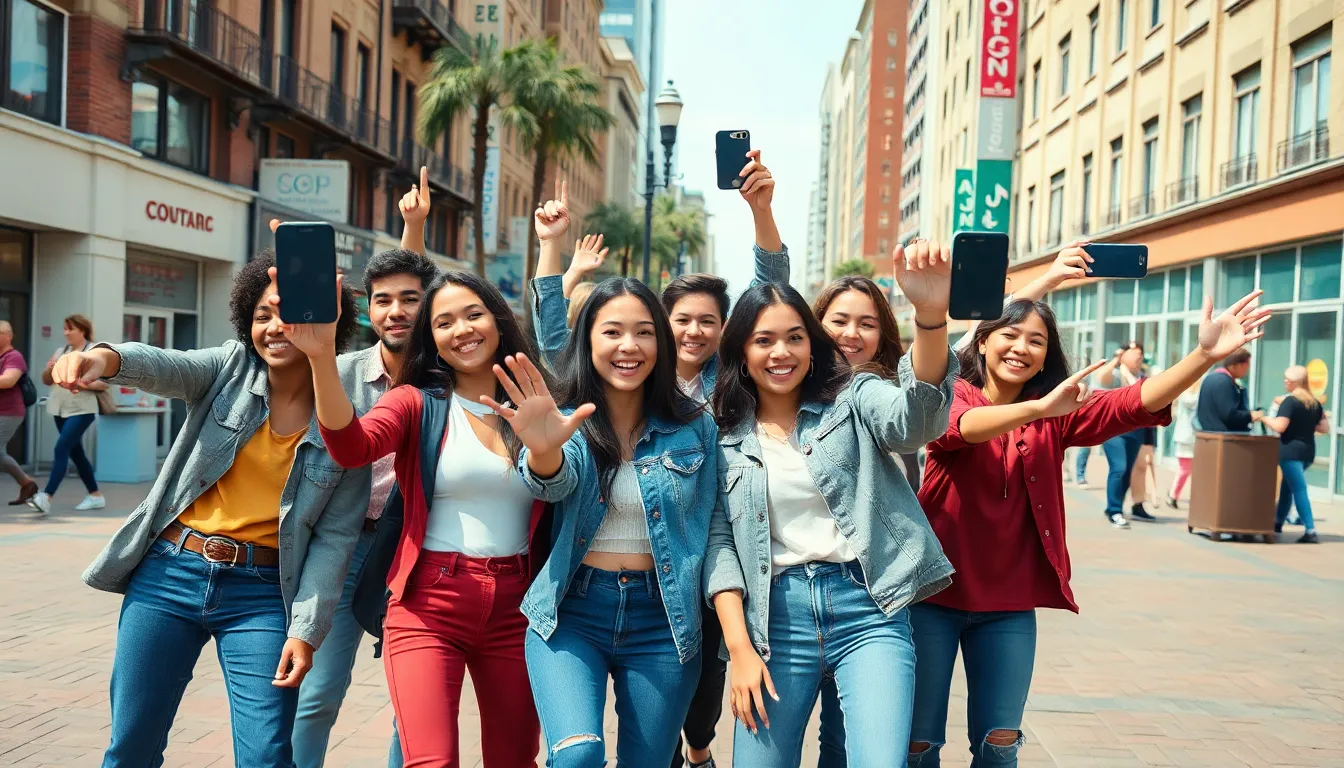In a world where scrolling through social media is practically a sport, digital influencers have become the rock stars of the online realm. With their carefully curated feeds and knack for turning everyday moments into viral sensations, they’re not just shaping trends; they’re redefining them. From fashion to fitness, these online personalities wield more power than a double shot of espresso on a Monday morning.
But what’s brewing in the world of digital influencers? As brands scramble to keep up, the latest trends are shifting faster than a cat video can go viral. Whether it’s the rise of micro-influencers or the growing demand for authenticity, staying ahead of the curve is essential. Buckle up as we dive into the quirks and quips of the digital influencer landscape, where the only constant is change—and maybe a few cute puppy posts along the way.
Table of Contents
ToggleOverview of Digital Influencer Trends
Digital influencers significantly shape consumer behavior, marking a shift in marketing strategies. Brands increasingly rely on these influencers to gain reach and credibility. Authenticity stands at the forefront of contemporary trends, as audiences connect more with genuine content rather than polished advertisements.
Micro-influencers, those with follower counts between 1,000 and 100,000, gain popularity due to their niche engagement and perceived credibility. Studies show that micro-influencers often generate higher engagement rates compared to traditional celebrities. As more brands seek effective marketing avenues, collaborations with micro-influencers become crucial for targeting specific consumer segments.
Visual platforms drive the rise of video content, with formats like TikTok and Instagram Reels capturing audience attention. These short videos engage viewers more effectively than static images. Storytelling within these visual formats enables brands and influencers to forge deeper connections with their followers.
Sustainability influences purchasing decisions, as consumers increasingly gravitate towards brands championing eco-friendly practices. Influencers promoting sustainable products resonate well with their audiences, further driving trend adoption.
Emerging technologies, such as augmented and virtual reality, create new opportunities for influencers. Brands embrace innovative approaches like virtual fittings and immersive experiences. This technological advancement reshapes promotional tactics, enhancing audience interaction.
User-generated content strengthens communities around brands. Encouraging followers to share their own experiences fosters a sense of belonging. Influencers facilitate this process, cultivating trust and loyalty among their audiences.
These trends illustrate a dynamic landscape that continues to evolve. As digital influencers adapt to these changes, their role in marketing remains essential across various industries.
Emerging Influencer Platforms

Digital influencer platforms are evolving rapidly, presenting new opportunities for creators and brands alike. Changes in user preferences drive these developments, with a focus on visual storytelling and authentic connections.
The Rise of TikTok
TikTok’s explosive growth reshapes influencer marketing strategies. With over 1 billion active users, this platform’s short-form videos attract diverse audiences. Creators leverage trending challenges, catchy sounds, and humor to engage followers. Influencer partnerships generate relatable content, enhancing brand visibility. Marketers recognize the platform’s impact, directing budgets towards authentic and entertaining campaigns. Additionally, TikTok’s algorithm favors creativity and engagement, allowing even micro-influencers to thrive.
Innovations on Instagram
Instagram remains a pivotal player for influencers, now focusing on innovative features. Reels, for instance, provide a platform for engaging video content, appealing to younger demographics. With a user base exceeding 2 billion, Instagram influences purchasing decisions significantly. Sponsored posts and Stories offer brands direct pathways to connect with consumers. Furthermore, Instagram’s shopping features streamline the purchasing process, enhancing convenience. Brands are increasingly collaborating with influencers for product launches and promotional campaigns to tap into dedicated followings.
Audience Engagement Strategies
Effective audience engagement strategies enhance influencer impact. Brands now prioritize personalization and community building to connect with consumers meaningfully.
Content Personalization
Content personalization involves tailoring messages based on audience preferences. Data analysis helps identify user interests, driving highly relevant content creation. Engaging posts resonate better when tailored to specific demographics, enhancing viewer satisfaction. Personalized recommendations encourage users to take action, increasing conversion rates. Using interactive polls or quizzes allows influencers to gather real-time feedback, adjusting content dynamically. For instance, a beauty influencer might share makeup tips based on selected skin types, fostering deeper connections with followers.
Community Building
Community building focuses on creating strong, loyal relationships among followers. Engagement increases when influencers interact regularly with their audiences through comments, live chats, and Q&A sessions. Hosting events, like virtual meet-and-greets, strengthens community bonds, allowing followers to feel more connected. Influencers can create dedicated groups where fans share their experiences, generating a sense of belonging. By highlighting user-generated content, influencers acknowledge followers and validate their contributions. This approach encourages more interaction, fostering lasting loyalty and trust in the brand.
Impact of Analytics and Data
Analytics and data have transformed the landscape of digital influencers. They provide insights that guide strategies and enhance audience engagement.
Measuring Success
Success measurement in influencer marketing relies on specific metrics. Brands monitor engagement rates, follower growth, and click-through rates to assess performance. Each metric reveals valuable information about how content resonates with target audiences. Tracking conversions helps determine the return on investment from influencer collaborations. It becomes clear that data-driven decisions fuel campaigns to achieve better results. Understanding trends and audience behavior furthers the ability to optimize future content.
Tools for Influencers
Influencers utilize various tools to harness analytics effectively. Platforms like Google Analytics and Hootsuite offer comprehensive data tracking solutions. Each tool provides insights into audience demographics and engagement patterns. Social media management tools, such as Buffer and Sprout Social, streamline content scheduling and performance monitoring. Automation tools, like Later, maximize efficiency by helping influencers plan their posts strategically. Utilizing these tools empowers creators to refine their approach and enhance their impact in an ever-evolving digital landscape.
Predictions for the Future
Digital influencers will increasingly leverage emerging technologies, particularly augmented reality and virtual reality. These innovations create immersive experiences, allowing audiences to engage with products in novel ways. Growth in video content remains a significant trend, especially on platforms like TikTok and Instagram Reels. The emphasis on storytelling will engage viewers, deepening connections between brands and consumers. Brands that value authenticity will likely collaborate more with micro-influencers, given their ability to foster trust and higher engagement rates, especially in niche markets.
Consumer preference for sustainability continues to rise. This shift necessitates that influencers align with eco-friendly brands, reflecting their audience’s values. The importance of personalization will grow. Tailored content that resonates with specific demographics enhances viewer satisfaction and increases conversion rates, making data analysis critical for successful campaigns.
Engagement strategies need adaptation. Regular interaction through comments and live sessions fosters community, encouraging audience loyalty. Analytics tools will gain prominence as influencers seek to refine their content strategies, focusing on metrics like engagement rates and follower growth. This data-driven approach supports continual improvement and optimization, ensuring influencer strategies remain relevant.
Collaboration across various industries will expand further. Influencer partnerships for product launches will become commonplace, enhancing brand visibility and credibility. As TikTok’s user base expands, marketers may allocate larger budgets toward entertainment-driven campaigns, recognizing the platform’s influence on audience behavior.
Overall, these trends shape the future of digital influencers, emphasizing adaptability, authenticity, and engagement in an ever-evolving landscape.
The landscape of digital influencers is rapidly evolving. As trends shift towards authenticity and sustainability, influencers are becoming crucial in shaping consumer behavior. Their ability to engage audiences through personalized content and community building is more important than ever.
Emerging technologies like augmented and virtual reality are set to redefine how influencers connect with followers. The rise of video content on platforms like TikTok and Instagram Reels continues to enhance storytelling, making connections deeper and more meaningful.
Brands must adapt their strategies to leverage these trends effectively. Collaborating with micro-influencers and focusing on data-driven insights will be key in navigating this dynamic environment. The future of influencer marketing promises exciting opportunities for those ready to embrace change.



